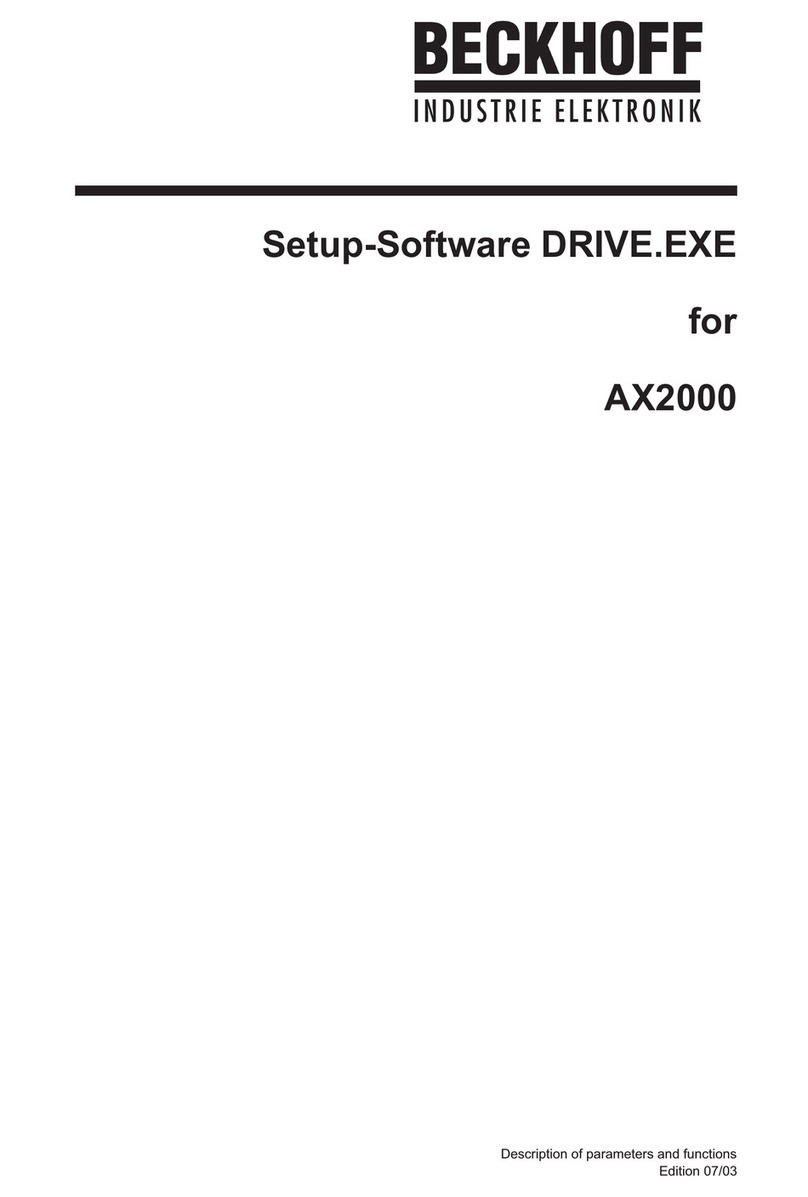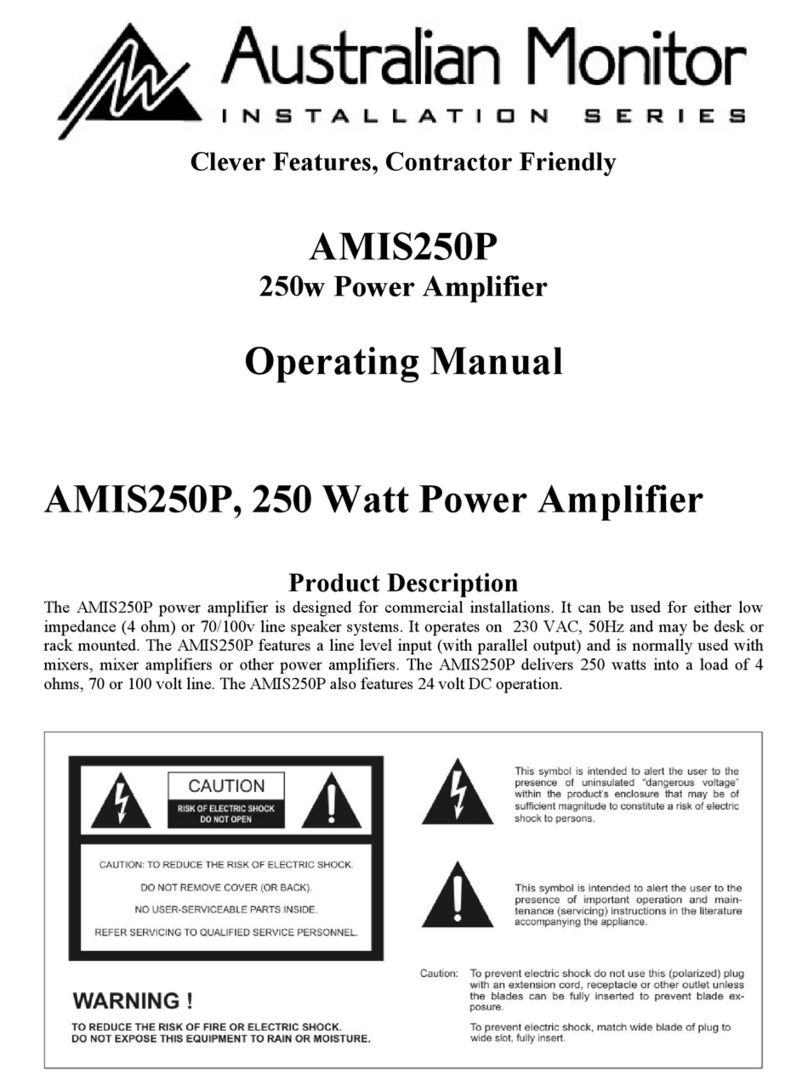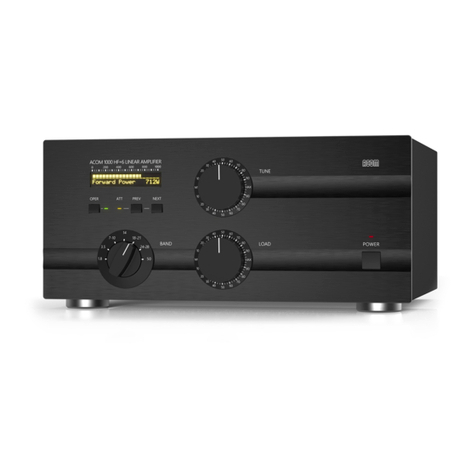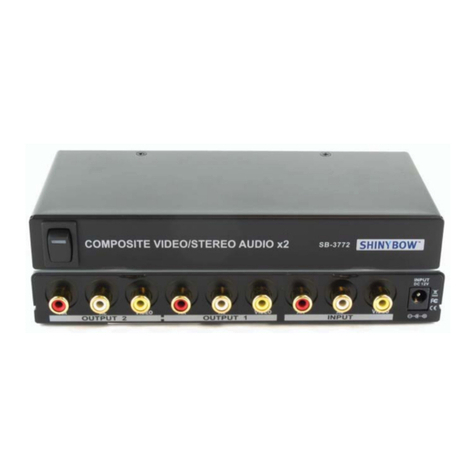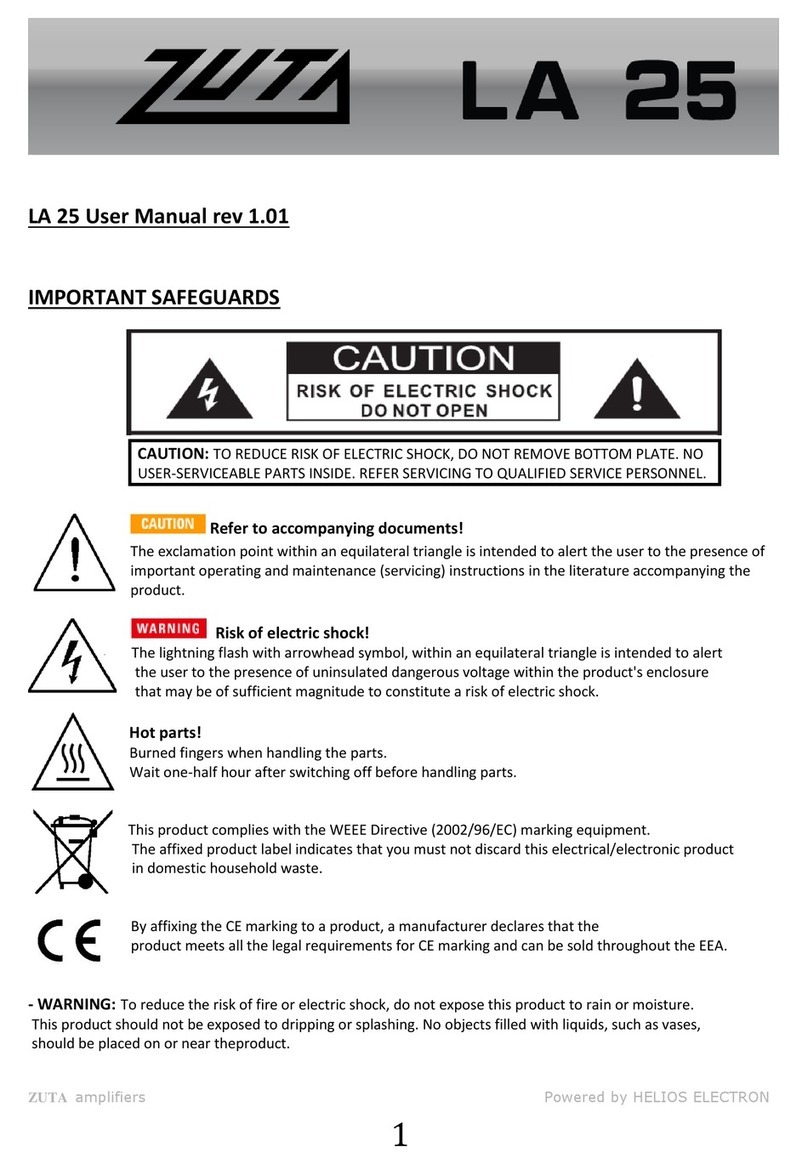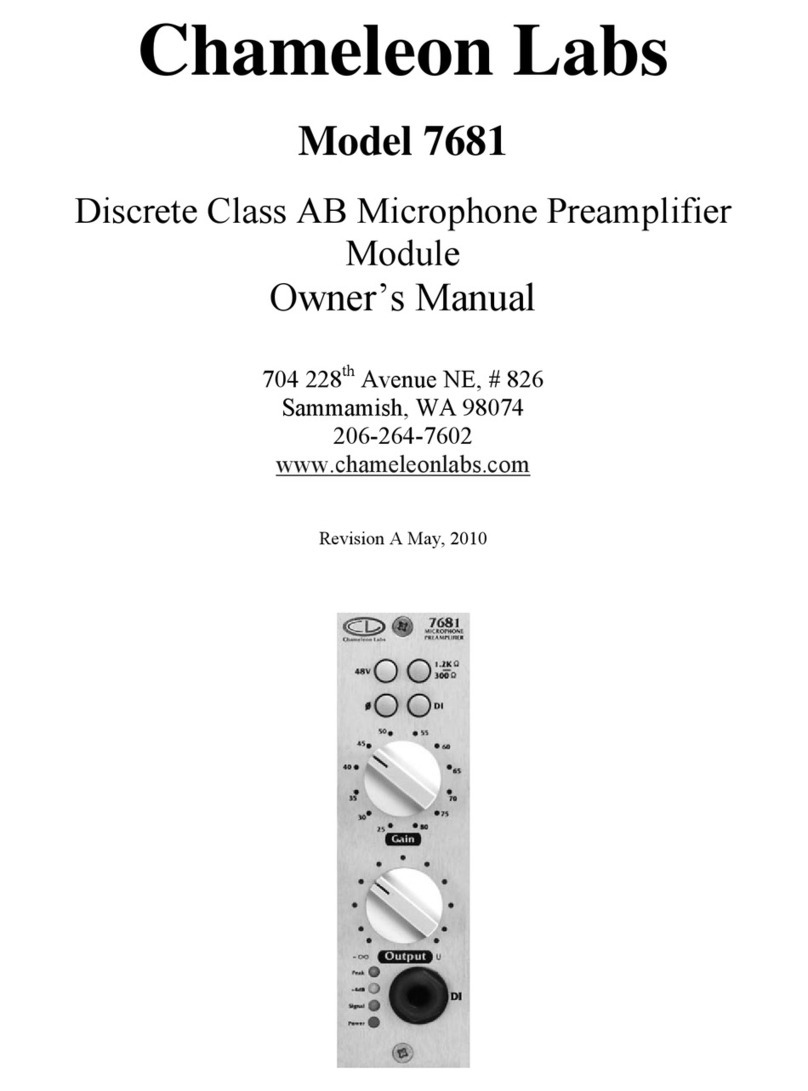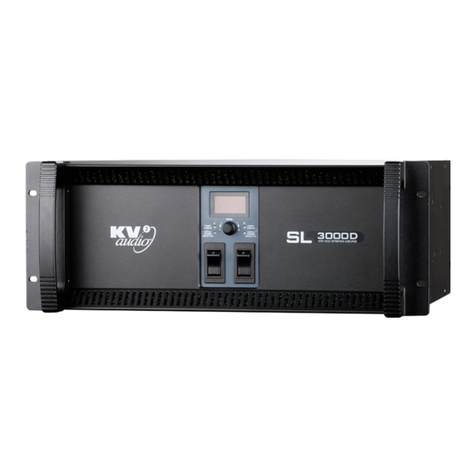SignVideo Proc Amp User manual

1
PROC AMP
(Video Processing Amplifier)
Instruction manual
PAMAN-19.PPP

2
CONTENTS
Features ........................................................................................... 3
Control Functions ............................................................................. 4
Hook up ........................................................................................... 5
Using the PROC AMP ..................................................................... 6
About monitors ................................................................... 6
Testing ............................................................................... 6
How to use the meter .......................................................... 7
Setting the luminance gain & black controls ....................... 8
Boosting dark scenes .......................................................... 8
Setting the hue & saturation controls .................................. 8
Removing color ................................................................. 8
Uses of the push button switches ....................................... 8
Y-C & Composite inputs .................................................... 10
Technical notes ................................................................... 10
Specifications .................................................................................. 11
PATENT NOTICE
This product is covered by two current patents:
U.S. Patent No. 4,604,646
U.S. Patent No. 5,311,298
Additional patent(s) pending.
Entire contents
1995, 2002, James A. Karlock, SignVideo
SAFETY WARNING
To prevent fire or shock hazard, do not expose the unit (or its power supply) to rain or moisture.
Unplug the unit form the wall outlet if it is not going to be used for an extended period of time..

3
FEATURES
The PROC AMP is a powerful, easy to use tool for the adjustment of video and chroma levels without
damaging the signal in any way. To this end, the PROC AMP has the following features:
• The original sync and blanking are passed untouched.
• Unity mode bypasses all controls and provides an output that is visually identical to the input.
• Video quality is to professional standards, allowing the PROC AMP to be left in line at all times.
• All controls are at unity when in the straight up position.
• All controls have marks for easy recording of their position.
• All controls have a range optimized for easy adjustment.
• Luminance gain and chroma saturation both go to zero to provide a black output.
• Black clipping begins at the blanking level and prevents video from interfering with sync.
• White clipping prevents excessive video level.
• Video level meter measures both peak white and black levels, giving you assurance that your output
video is within industry accepted standards and thus will play properly on all TV sets and monitors.
• Meter clip LEDs light just BEFORE clipping begins, warning you that video levels are in the clipping
region.
• Video with degraded sync can be restored to a standard 40 IRE by pressing the SYNC button.
• Color burst can be removed to provide a true monochrome signal.
• Split screen allows comparison of uncorrected and corrected video.
• Composite video is internally split and recombined without the artifacts often found in competitive
units.
• Frequency response is flat well beyond 5 MHz.

4
PUSH BUTTON SWITCHES
POWER
Push in to apply power to the PROC AMP. When
off, no power is consumed and no video is passed
to the output
.
UNITY
Push in to
bypass
all controls and set the video
output essentially equal to the video input.
SPLIT
Push in to display a split screen. The right side of
the screen is uncorrected (“UNITY”) video and the
left side of the screen is corrected video.
MONO
Push in to produce a monochrome (black & white)
picture by removing the color burst.
SYNC
Push in to ensure that the output sync is always
40 IRE as long as the input sync is greater that 30
IRE. Note that this affects the way that the video
level meter works.
ROTARY CONTROLS
luminance black
Shifts the entire visible video signal either brighter
or darker in order to set the blacks at the desired
level. The meter should read 7.5 on scenes that
contain a really dark object. If the black clip LED
lights, you should adjust clockwise to stop clipping
(see USING THE PROC AMP).
luminance gain
Adjusts the gain of the luminance (or brightness)
portion of the picture. Does not adjust chroma
along with luminance so it cannot be used as a
fader control. Use it to set the brighter regions of
the picture to the desired level. Meter should read
80-100 on scenes containing whites. If the clip
LED lights, the level is excessive (see USING THE
PROC AMP).
chroma saturation
Adjusts the color saturation (also called chroma
gain or chroma level). Set by eye with a good
video monitor.
chroma hue
Adjusts the color hue (also called tint or phase)
Set by eye with a good video monitor.
METERING
The video level meter reads (1) peak white video
level on the right and (2) peak black video on the
left. The upper set of numbers is for reading the
white level. The lower set of numbers is for read-
ing the black level. Normal video will extend from
7.5 to 100, with 7.5 being the minimum and 100
being the maximum. Going outside of this range
produces nonstandard video that will cause prob-
lems with some equipment.
CONTROL FUNCTIONS
20 40 60 80 100 CLIP
CLIP 5 7.5 10
v i d e o l e v e l
b l a c k l e v e l
black gain saturation hue
un ity unity unity unity
P OWER UNITY SPLIT MONO SYNC
luminance chroma
Sign Video Proc Amp

5
CONNECTIONS
Occasionally, when a new piece of equipment is
added to a system, something is moved or dis-
connected and the new equipment is blamed for
problems that occur. Follow the below procedure
to ensure that the installation goes smoothly:
1.
Decide where to place the PROC AMP; both
physical placement and where to connect in the
stream of equipment. We suggest that it be con-
nected to the output of the VCR or camera before
any other equipment. Use of a VCR as your signal
source is assumed in the following:
2.
Before hooking up the PROC AMP, turn on all
equipment and play a tape to verify that all equip-
ment is operating normally. Verify a picture by us-
ing a video monitor that is connected to the last
item in your processing chain.
3.
Disconnect the video output cable from the
VCR output. Verify that the picture went away.
Plug this cable into the video output of the PROC
AMP.
4.
Plug one end of a new cable into the VCR out-
put connector. (the one you just removed the ca-
ble from). Plug the other end of it into the input of
the PROC AMP.
5.
Plug the PROC AMP power supply into a wall
outlet . Then, plug the power supply cord into the
PROC AMP’s “6-9 v ac” power input.
6.
Push the power button so that it stays in. A
picture should appear on your monitor
Y-C & COMPOSITE INPUTS/OUTPUTS
The PROC AMP
has both composite and Y-C
inputs and outputs.
Apply video to only one in-
put at a time
, if video is fed into both inputs they
will mix causing severe distortion. If possible, use
the Y-C input as it avoids the Y-C splitting step in-
ternally in the PROC AMP.
If you use the Y-C input
, the Y-C output will pro-
vide the best quality output. The composite output
is convenient for feeding a composite monitor.
If you use composite input,
the composite out-
put will generally provide the best quality output.
Video Processing Am plifier Made in U.S.A.
This product covered by:
U.S. Patent N o. 4,604,646
U.S. Patent N o. 5,311,298
O th er Patent
(
s
)
pe n din g
6-9 vac power
600 m a
video input
video output
Y-C compo site Y-C composite
HOOK UP

6
About video monitors
A good monitor
is your most important asset
when setting video parameters. It should be fully
DC restored in order to properly display bright-
ness.
A DC restored monitor
is one that fades to black,
not gray, during a slow fade out. Other monitors
can be adjusted to have proper blacks on one
scene, but when the scene changes, the blacks
will become gray or will lose detail (disappear by
being too black).
To set your monitor:
1.
Choose a static shot from tape or camera that
has good blacks and good whites. Turn on the
PROC AMP and press the SYNC button, be sure
that all other buttons are out. Set all controls
straight up to unity.
2.
Using the meter, adjust the black luminance
control so that the “7.5” LED on the left lights up
but the “5” LED light is dark. Adjust the luminance
gain control so that the “100” LED just comes on.
(All of the LEDs in between these two will be lit).
The output video now extends from about 7.5 to
100 IRE. (The controls interact somewhat, so re-
adjust both until the “7.5” and “100” LEDs just
light.)
3.
With the room lights off, adjust the brightness
and contrast (or gain or picture) controls on your
monitor so that the blacks are black, but still have
detail and the whites look white. Contrary to what
some manuals recommend, the brightness control
should be used to set the blacks and the contrast
control should be used to set the brightness of the
whites.
4.
The color settings should be set with color bars
connected directly to the monitor input. (the PROC
AMP does not provide color bars).
Once your monitor is accurate, you can use it for
most video adjustments, relying on the PROC
AMP meter primarily for the white readings and
occasionally for black readings.
USING THE PROC AMP
TESTING THE PROC AMP
The following procedure will verify that your PROC AMP is performing normally.
1.
Press UNITY. The output picture should be visually identical to the input picture in every respect.
2.
Press SPLIT, then release UNITY. There should be no visible change in the right side of the picture.
The left side may change depending on the control settings.
3.
Adjust each control. Each control should affect only the left side of the screen. (see CONTROL
FUNCTIONS for an explanation of what each control should do)
4.
Release the SPLIT button. Adjust each control. Verify that each works. Luminance black and lumi-
nance gain controls should affect the meter reading.
5.
Press the MONO button. The color should disappear giving a monochrome (black & white) picture.
Some monitors may give wildly off colors due to excessive “color killer” threshold sensitivity. These usu-
ally disappear when the PROC AMP chroma saturation control is turned fully counterclockwise.

7
METER BASICS
The meter is a horizontal bar made up of light
emitting diodes (LEDs) that light in sequence as
the reading increases.
Video inputs and outputs of most equipment, in-
cluding this PROC AMP, are nominally 1 volt (1v)
peak to peak (p-p) to a 75
Ω
transmission line. For
measurement purposes, this is usually split into 40
units of sync and 100 units of video with the sync
being the most negative portion of the signal for a
total of 140 units. This measurement system is
expressed in IRE units:
In the NTSC video system (used in the United
States, Canada, Japan & some other countries)
the bottom 5-10 IRE of the video is left unused,
the blackest black being in this region at about 7.5
IRE.
The left most LED, marked “CLIP”, lights when
blacks are being clipped at blanking or 0 IRE. The
next 3 LEDs, marked “5, 7.5 and 10”, indicate the
level of the blackest parts of the output video sig-
nal. If there is no video at or below 10 IRE, then
these LEDs will remain off.
The right most LED, marked “CLIP” indicates
white clipping while the 5 LEDs to the left, marked
“20, 40, 60, 70,100” indicate peak video level.
These light in a bargraph fashion. If none of these
are lit, the video has no white peaks above 20
IRE.
It is a good idea to get familiar with the action of
the meter by studying some of your tapes that look
good and some that don’t look good.
METER DETAILS
1.
The meter reads relative to the sync so that it
will give accurate readings in an environment
where the video level may deviate from 1v p-p.
100% is set so that the 100 LED comes on when
the video is 2.5 times the sync. All other LEDs are
scaled from this 100% reference. This is ideal for
feeding a VCR that has an automatic gain control
(AGC), since any deviations from 1v p-p will be
corrected by the VCR.
2.
When the SYNC button is pressed, the sync is
set to 40 IRE for a 1v p-p output. Under this condi-
tion, the meter reads 100% when the video is 1v
p-p. If the video is to be fed to a device that does
NOT have an AGC then this is generally the pre-
ferred mode.
3.
The meter reads black and white peaks that
are about 5
µ
s or more wide. Narrower objects
will read if they are more than one line high.
4.
The meter measures both black and white
within a rectangle just slightly smaller than the
overall picture.
HOW TO USE THE METER
100 IRE
7.5 IRE
0.0 IRE
-40 IRE
sync
color
burst
white video
black video
1 4 0 IRE
to ta l
20 40 60 8 0 10 0 CL IP
C LIP 5 7.5 10
v i d e o level
b l a c k l e v e l

8
SETTING LUMINANCE
Gain
Adjust the
luminance gain
so that, for normal
scenes, the video level does not exceed 100%.
This occurs when the 100% LED lights some-
times, and the CLIP LED
NEVER
lights. Normal
video scenes will vary greatly, typically from
60-100 as people move around, the camera pans
across bright objects, etc.
Black
Adjust the
black
control so that the blacks are
black and still have detail on a properly calibrated
monitor (see “about video monitors”). The monitor
is best for general use but the black level meter
can be used when you want to be sure something
is really black. Set the black control so that the 7.5
LED is on and the 5 LED never comes on. Like
the white level, the black level will move around
quite a bit, so don’t try to set every scene to 7.5
IRE black. However the 5 IRE LED, and
especially the CLIP LED, should remain off.
Meter action
As stated earlier, it is a good idea to get familiar
with the action of the meter by studying some of
your tapes that look good and some that don’t look
good.
Boosting dark scenes
View the video monitor and turn up the luminance
gain until the scene looks normal. The luminance
black will probably need adjusting too. When you
turn up the gain, small highlights will be turned up
to the clipping level causing the CLIP LED to light.
This is acceptable since it is intended. If the high-
lights have color, the color will be preserved. After
the gain and black are set, adjust the hue and
saturation as desired for the best picture. Expect
the picture to get somewhat noisier (snowier).
SETTING CHROMA
Method
The chroma controls are best set by eye on a
monitor that is known to be accurate. Even TV
stations do this by eye since a vector scope is of
little value in day to day production use.
Hue
Like all broadcast style PROC AMPs, the hue con-
trol affects only colored areas of the picture - it
has no effect on whites or neutral grays.
To correct for a picture that is too green, turn the
hue control counterclockwise. To correct a picture
that is too red, turn the hue control clockwise.
Saturation
Turn clockwise to increase the intensity (satura-
tion) of the color. Turn counterclockwise to reduce
the intensity of the color.
The color portion of a video picture is surprisingly
noisy as can be seen by turning the chroma satu-
ration fully clockwise. Fortunately, most situations
just require a small adjustment.
Removing Color
Turn saturation fully counterclockwise to remove
the color from a scene such as black and white
photos etc. (If you are using composite input this
will slightly soften the picture). If your whole pro-
gram is monochrome, you can also kill the color
burst with the MONO switch (see “MONO”).

9
UNITY
UNITY is used to set the PROC AMP so that it
does not affect the video signal. Its output is
equal to its input. This is useful to verify what the
picture looks like with and without correction.
Details
of the UNITY mode:
1.
No control has any effect on the output.
2.
Both the composite and the Y-C outputs are
active.
3.
The meter reads normally.
4.
Internally, the video is set to a standard voltage
with “clamping” circuits. These remain active.
SPLIT
SPLIT is used to verify what the picture looks like
with and without correction. The corrected video
is on the left side of the monitor. Uncorrected
video is on the right. Use of the SPLIT or UNITY
controls is a matter of personal preference.
Details
of the SPLIT mode.
1.
The controls affect only the left side of the pic-
ture.
2.
In the split screen mode, the hue control af-
fects fine picture detail.
3.
The meter reads only the left, corrected portion
of the picture.
MONO
The MONO mode suppresses the color burst so
that downstream TVs and VCRs will switch to the
monochrome mode (Black & white). It has no
other effect on the video. This mode should be
used for whole programs, not parts of a program
as many VCRs and TVs show a flash of excess
color when entering the monochrome mode. If
you have monochrome scenes in a color program,
turn the saturation control to zero for these scenes
instead of selecting mono.
Details
of the MONO mode:
1.
Color burst is suppressed to about -40 dB.
2.
Some video signals (especially VCR outputs)
have excessively wide color burst and the outer
edges of this burst may not be suppressed, caus-
ing some monitors/TV to remain in the color mode.
This is especially true of VCR outputs.
3.
Some TV sets simply refuse to switch to mono-
chrome. Try turning the PROC AMP’s chroma
saturation control fully counterclockwise. This will
loose some detail if you are using composite input.
There is no loss of detail if you are using Y-C in-
puts.
SYNC
Normally the PROC AMP passes sync unchanged,
giving maximum protection against accidental sync
degradation. When the SYNC button is pressed,
proper sync amplitude is ensured by forcing the
sync to the standard 40 IRE amplitude. This is
used whenever the input video has a loss of sync
amplitude that can cause tearing or vertical jitter.
This is useful for feeding monitors or mixers but is
generally unneeded with
good quality video
or
when feeding VCRs since they have an automatic
gain control to normalize the level.
Details
of the SYNC control:
1.
Provides 40 IRE sync output as long as the
input sync is greater than 30 IRE.
2.
Operates by amplifying the center portion
(10-30 IRE) of the sync to the nominal 40 IRE.
3. See “INTERNAL JUMPER OPTIONS” for an
alternative mode for this switch.
USING THE PUSH BUTTON SWITCHES

10
TECHNICAL NOTES
Composite and Y-C inputs/outputs
The composite output is derived from the outputs of the Y and C output amplifiers by first mixing them in
a 1:1 ratio, then amplifying by two to drive the 75
Ω
output.
The composite input is split right at the input by a simple filter circuit then essentially applied to the Y
and C inputs. The overall circuit is arranged so that the Y and C signals which were split at the input
recombine with no visible artifacts at the output after passing through the processing circuitry.
Since the composite input splitting filter allows high frequency Y to go through the chroma section, the
composite input should not be used when the primary output is Y-C. One exception to this general rule
is where the video signal has no high frequency Y. In this case the Y-C splitting will be accomplished
without the comb filter artifacts normally associated with VCRs. Video sources that do not have high
frequency Y include standard VHS and Beta VCRs as well as most earlier cassette tape formats (1/2”
EIAJ, 3/4”). Note: It is possible to add Y-C outputs to most of these machines since the Y and C are re-
corded separately on the tape.
Luminance control areas
The luminance gain and chroma saturation controls affect 100% of the picture area of the video signal.
The luminance black control leaves a small border at the far edges of the picture uncorrected. This re-
gion is well out of the “Safe Area” and should be invisible on all TV sets and monitors.
INTERNAL JUMPER SETTINGS
Two options are available by moving internal jumpers.
1. SYNC
. This jumper selects between two types of sync processing when the SYNC button is pressed.
The PROC AMP is shipped with the jumper connecting the two pins closest to the front panel. In this
position, pressing the SYNC button, selects sync that has been shaped by expanding the middle 20 IRE
to fill the full 40 IRE. The output video always has 40 IRE of sync as long as the input video has at least
30 IRE of sync. This mode is best for general use with normal video as it only does the minimum proc-
essing sufficient to handle most video. (If video, at the start of blanking, infringes in the sync region be-
low 10 IRE, it will appear in the processed sync and can cause horizontal instability making this mode
unusable in that instance. Video in the active picture region is always prevented from infringing on the
sync). Removing this jumper provides output video without sync (non-composite video).
If the jumper is moved to connect the two pins furthest from the front panel, sync from the sync separa-
tor is used for the output video. This sync will be 40 IRE as long as there is at least 10 IRE of sync on
the input video. This mode can restore video that is so bad that few monitors will display a normal pic-
ture. It also has a 200 nanosecond delay which shifts the picture slightly to the left. Because of this de-
lay, we do not recommend the general use of this mode.
2. Video clamp.
This jumper deactivates the video clamp during the entire vertical blanking period.
The PROC AMP is shipped with this jumper OPEN. If the shorting plug is moved so as to connect the
two pins, the video clamp will be deactivated during vertical blanking. This can help pass severely de-
graded video and some types of nonstandard video. Try moving this jumper if your picture is dark or
flashing at the top.

11
General
Input level 1v p-p nominal to 75
Ω
. Works with 0.5-1.5 v p-p.
Output level Normal mode:
Same voltage as input ±.5 dB. to 75
Ω
SYNC shaped mode:
` 1v p-p for 100% meter reading
Distortion: Composite in/out:
Differential gain: 1% max.
Differential phase: 1° max.
Y/C in/out:
Luminance channel differential gain at
3.58MHz: 1% max.(measured with black &
white clipping circuits internally disabled)
Frequency response Composite in/out:
±1.0 dB to 10 MHz. (including any Y/C
separation and recombination artifacts)
Y/C in/out:
±1.0 dB to 10 MHz.
Signal to noise ratio Better than 60 DB (including HUM & noise)
Resolution (see note) 800 lines
at no more than 1.0 db down
. (see note)
1600 lines
at no more than 6 db down
. (see note)
Control adjustment ranges
luminance black: ±15 IRE
luminance gain: -40 dB to +6 dB
Chroma saturation: -35 dB to +6 dB
Chroma hue: ±35° min.
Miscellaneous
Mono mode: Burst suppressed to -40 dB min.
Color System NTSC, 3.58 MHz.
Dimensions 9.17” wide, 2.45” high, 6.91” deep
Power Requirements 6-12V ac 400 ma supplied by plug in wall transformer.
Cabinet construction All metal - painted aluminum
Note about resolution
: Like specifying camera sensitivity without stating a signal to noise ratio, specify-
ing resolution without also stating a response level is meaningless. We have stated resolution at full re-
sponse (-1.0 dB ) and at mild degradation (-6dB). When comparing specs with other manufacturers, be
sure to ask how it was measured.
SPECIFICATIONS
Table of contents
Other SignVideo Amplifier manuals
Popular Amplifier manuals by other brands

Rockford Fosgate
Rockford Fosgate Punch X150.1 Installation & operation
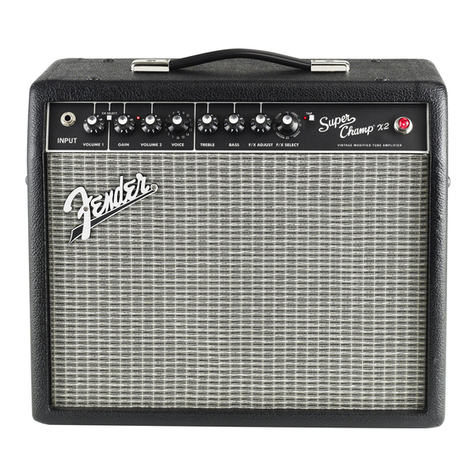
Fender
Fender Super Champ X2 owner's manual

Mackie
Mackie Sound Palette SP1200 instruction manual
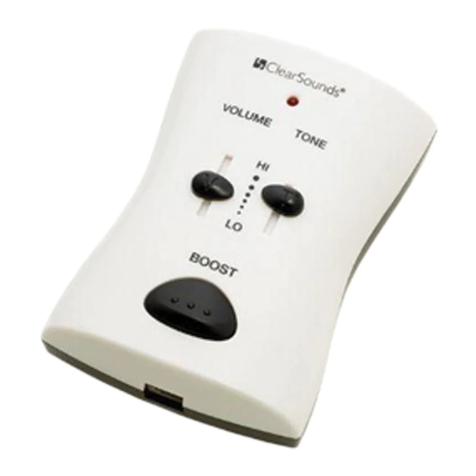
ClearSounds
ClearSounds CS-IL95W manual
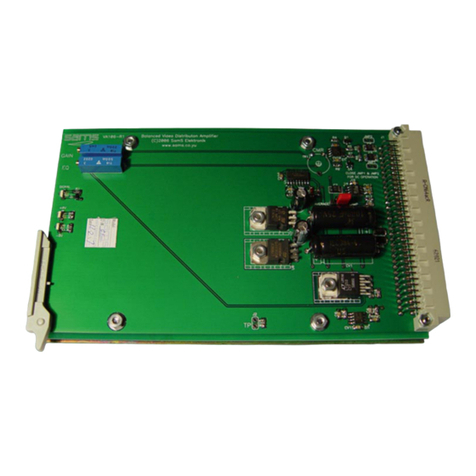
Sams
Sams VA-106 User manual for use and maintenance

Comprehensive
Comprehensive CVG-5ARII user manual



